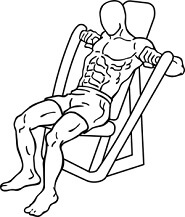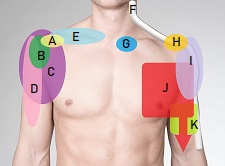- Home
- Diagnosis Guide
- Collarbone Pain
Collar Bone Pain
Written By: Chloe Wilson BSc (Hons) Physiotherapy
Reviewed By: SPE Medical Review Board
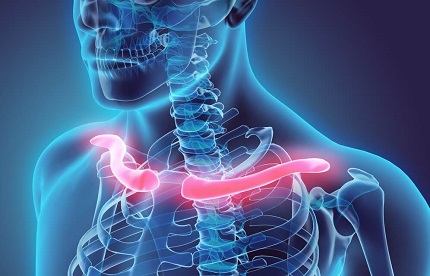
Collar bone pain is a common problem and can be due to a number of different issues.
The clavicle bone itself may be broken or suffering from wear and tear, the surrounding ligaments injured or occasionally there may be something more sinister going on.
Here we will look at the most common causes of clavicle pain, what causes them, how they differ and the best treatment options. If you have swelling or a lump around your clavicle, the check out the Collarbone Lumps article.
Clavicle Anatomy
The clavicle or collarbone is roughly 15 cm long and connects the arm to the body through two joints:
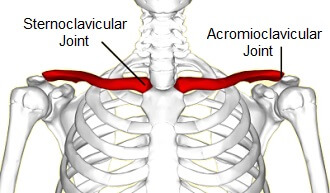
- Sternoclavicular Joint: at the inner end with the breastbone aka sternum
- Acromioclavicular Joint: at the outer end with part of the shoulder blade known as the acromion
Both joints are surrounded by strong ligaments to hold them in place, and a number of the neck and shoulder muscles attach to the clavicle.
Related Article: Shoulder Joint Anatomy & Function
Common Causes of Collar Bone Pain
Any damage to the collar bone or surrounding soft tissues can lead to clavicle pain. Now we know a little about clavicle anatomy, let's look at the most common causes of collar bone pain.
1. Broken Collar Bone
Clavicle fractures are by far the most common cause of collar bone pain. In fact, the collar bone is the most common bone to break in the body. Luckily though clavicle fractures are usually
simple to treat and in most cases will have healed within three months.
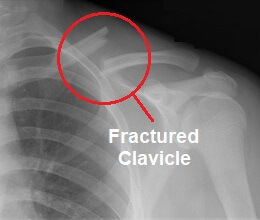
Causes: Most commonly a fall onto the shoulder or on an outstretched arm or less often a direct blow to the collar bone or an RTA
Symptoms: Collar bone pain especially if you place gentle pressure on the bone which may spread to the shoulder, deformity (a lump over the fracture, in severe cases breaking the skin) and limited shoulder movement which may be accompanied by a clicking/grinding noise
Treatment: In most cases clavicle fractures are treated non-surgically with a sling and physical therapy, but in some cases surgery may be required to fix the broken pieces back together
Recovery: the bone usually heals in 3-6 weeks in children, 6-12 weeks in adults. People usually make a full recovery by around 3 months
You can find out loads more about this common cause of collar bone pain in the Clavicle Fractures section, including treatment options and the recovery process.
2. ACJ Ligament Injury
The acromioclavicular joint, ACJ, is held in place by four strong
ligaments. Damage to any of these ligaments can cause instability and clavicle pain. The ACJ ligaments may be overstretched, partial torn or
completely ruptured depending on the severity of the injury.
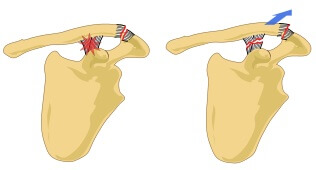
Causes: A fall onto the shoulder when the arm is by your side, fall onto an outstretched hand, repetitive heavy lifting
Symptoms: Collar bone pain that is worse with arm movements, particularly reaching up, pulling, pushing or heavy lifting. Arm range of movement may be restricted
Treatment: Minor ACJ ligament injuries will be treated with a sling for 2-3 weeks and physical therapy. If the ligaments have completely ruptured causing dislocation of the clavicle then surgery will be advised
Recovery: Ligaments usually take longer to heal the bone as they have a poor blood supply. It can take months to recover fully from acromioclavicular ligament injuries and for the collar bone pain to settle.
3. Acromioclavicular Joint Arthritis
Inflammation and degeneration (arthritis) of the cartilage and bones of the ACJ is another cause of collar bone pain. With acromioclavicular arthritis, the space between the two bones, the clavicle and the acromion, reduces and the surfaces of the bone may become bumpy instead of smooth. This leads to friction and pain.
ACJ arthritis may be due to the normal aging process or may be accelerated by certain activities. In children and young adults, the joint space (space between the two bones) is usually around 1-3mm. By the age of 60, this has usually reduced to around 0.5mm or less.
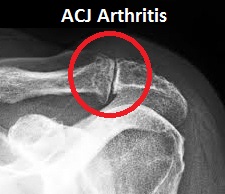
Causes: Aging, repetitive or prolonged over-head activities such as weightlifting or construction work and contact sports
Symptoms: Mild to moderate collar bone pain over the distal end of the clavicle (nearest the shoulder) which may spread to the shoulder and chest. Pain gets worse if you reach across your chest, known as horizontal adduction as it compresses the joint
Treatment: Physical therapy, activity modification, anti-inflammatory medication and injections. In severe cases, which is rare, surgery may be done to remove a small part of the collarbone so there is more space between the clavicle and acromion – this is known as a resection arthroplasty or ACJ Excision. After surgery you will need to wear a sling for a few days and have physical therapy
Recovery: Degenerative changes to the cartilage and bone cannot be undone but by strengthening the muscles and ensuring good posture you can take the pressure of the AC joint and reduce pain and inflammation either altogether or to a manageable level. After ACJ surgery, you can usually return to work after a week or so but you should avoid any overhead activities for 3 months. It can take a year to make a full recovery
4. Distal Clavicular Osteolysis
Distal Clavicular Osteolysis, more commonly known as Weightlifters Shoulder, is a condition where tiny breaks develop in the distal end of the clavicle, near the shoulder. Repetitive forces through the bone, e.g. from frequent training, mean it doesn’t get a chance to heal and the bone gradually breaks down and is reabsorbed, known as Osteolysis, faster than it can be repaired.
Causes: Repetitive trauma from heavy overhead activities such as weightlifting and plastering and excessive traction on the AC joint in activities where the elbows end up behind the body such as bench presses
Symptoms: Collar bone pain usually directly over the acromioclavicular joint, usually a dull ache. Shoulder movement is not usually affected but it will be painful to cross the arm across the chest. Pain from distal clavicular osteolysis usually gets worse with overhead activities, heavy lifting and throwing
Treatment: Weightlifters Shoulder usually resolves completely within a couple of years essentially by avoiding aggravating activities. Medication, injections and physiotherapy can help reduce the symptoms of clavicle pain. If symptoms fail to settle, surgery may be performed to remove a small portion of the distal clavicle followed by physical therapy to restore range of movement and strength
Recovery: It can take up to two years to recover from distal clavicular osteolysis, and even then, collar bone pain often returns if you start doing any aggravating activities regularly again
5. Acute Osteomyelitis of the Clavicle
Osteomyelitis is an infection that develops in the bone and is a very rare cause of collar bone pain.
Causes: Infection may develop after an injury to the bone or may pass into the bone through the bloodstream after an infection (usually bacterial) somewhere else in the body. It is also a rare side effect of head and neck surgery
Symptoms: Severe collar bone pain, fever, swelling and the area may appear red and hot
Treatment: Intravenous antibiotics, usually for around 4-8 weeks. Early treatment is vital to stop the progression of the disease. In severe cases surgery may be required to remove any infected or dead tissue
Recovery: Collar bone pain from Osteomyelitis will usually settle after a month or two of antibiotics, but can return, usually if the patient has an underlying medical condition such as poor circulation or a weakened immune system
6. Sternoclavicular Joint Injury
Injuries to the proximal end of the clavicle where it joins the sternum is another rare cause of collar bone pain. Ligaments hold the sternoclavicular joint together and occasionally one or more of these ligaments may get over stretch or rupture completely. This can lead to dislocation, usually anteriorly (forwards), of the sternoclavicular joint.

Causes: A significant blow to the shoulder (front or back) or to the top of the collarbone e.g. from an awkward sporting tackle or car accident
Symptoms: Proximal clavicle pain (near the breastbone), visible lump over the joint
Treatment: Usually a combination of rest from aggravating activities and physical therapy. Very rarely surgery may be required
Recovery: It usually takes a few weeks for the collar bone pain to settle but it may take a few months to make a full recovery
Rare Causes of Clavicle Pain
Other possible causes of collar bone pain include:
- Bone Tumour: which may be benign or malignant
- Thoracic Outlet Syndrome: where there is compression of the vein, arteries or nerves in the space between the collar bone and first rib
Treating Collar Bone Pain
Treatment for collar bone pain will depend on the underlying cause of the pain but will usually involve:
- Medications: Pain relieving and anti-inflammatory medication to reduce pain and inflammation
- Ice/Heat: Regularly applying ice to acute injuries (first 2 weeks) or heat to chronic injuries (6 weeks +) can help to reduce pain and inflammation and speed up healing
- Exercises: Stretching out the muscles at the front of the shoulder with arm stretches, strengthening the muscles around the shoulder blades with scapular stabilization exercises, and rotator cuff strengthening are a vital part of rehab for almost all causes of collar bone pain
Surgery may be required if the bone has been injured or there is excess bone growth contributing to the problem.
What Else Can Help?
By far the most common cause of collar bone pain is a fracture. You can find out more about the treatment and recovery process in the clavicle fractures section.
If you have a lump on or near your clavicle, check out the collarbone lumps section. If your pain is elsewhere and you want help working out what is wrong, visit the shoulder pain diagnosis section.
Most cases of collar bone pain will benefit from exercises to stretch and strengthen the shoulder - visit the shoulder exercises section to find out more.
You may also be interested in the following articles
- Front Shoulder Pain
- Burning Shoulder Pain
- Sharp Pain In The Shoulder
- Shoulder Pain At Night
- Shoulder Pain When Lifting Your Arm
Related Articles
Page Last Updated: November 5th, 2024
Next Review Due: November 5th, 2026
